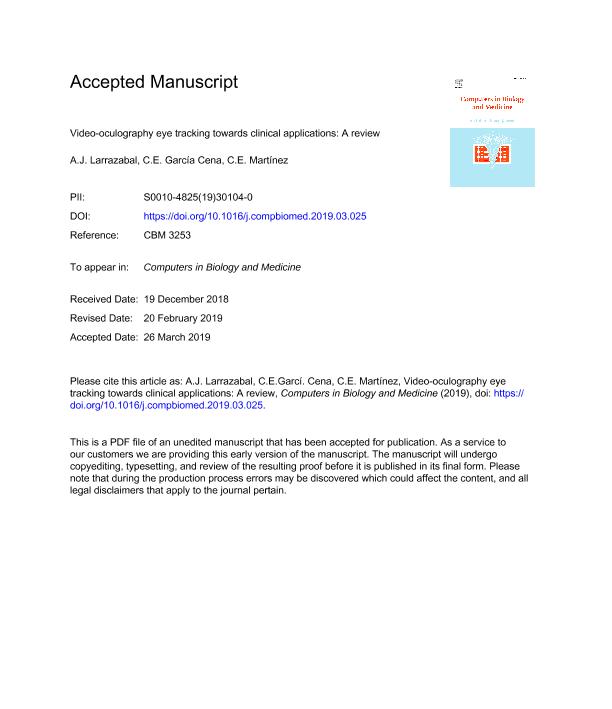Mostrar el registro sencillo del ítem
dc.contributor.author
Larrazabal, Agostina Juliana

dc.contributor.author
García Cena, Cecilia Elisabet

dc.contributor.author
Martínez, César Ernesto

dc.date.available
2023-09-07T10:37:15Z
dc.date.issued
2019-05
dc.identifier.citation
Larrazabal, Agostina Juliana; García Cena, Cecilia Elisabet; Martínez, César Ernesto; Video-oculography eye tracking towards clinical applications: A review; Pergamon-Elsevier Science Ltd; Computers In Biology And Medicine; 108; 5-2019; 57-66
dc.identifier.issn
0010-4825
dc.identifier.uri
http://hdl.handle.net/11336/210779
dc.description.abstract
Most neurological diseases are usually accompanied by a broad spectrum of oculomotor alterations. Being able to record and analyze these different types of eye movements would be a valuable tool to understand the functional integrity of brain structures. Nowadays, video-oculography is the most widely used eye-movements assessing method. This paper presents a study of the existing eye tracking video-oculography techniques and also analyzes the importance of measuring slight head movements for diseases diagnosis. In particular, two types of methods are reviewed and compared, including appearance-based and feature-based methods which are further subdivided into 2D-mapping and 3D model-based approaches. In order to demonstrate the advantages and disadvantages of these different eye tracking methods for disease diagnosis, a series of comparisons are conducted between them, addressing the complexity of the system, the accuracy achieved, the ability to measure head movements and the external conditions for which they have been designed. Lastly, it also highlights the open challenges in this research field and discusses possible future directions.
dc.format
application/pdf
dc.language.iso
eng
dc.publisher
Pergamon-Elsevier Science Ltd

dc.rights
info:eu-repo/semantics/openAccess
dc.rights.uri
https://creativecommons.org/licenses/by-nc-sa/2.5/ar/
dc.subject
DISEASE DIAGNOSES
dc.subject
EYE GAZING
dc.subject
EYE TRACKING
dc.subject
HEAD MOVEMENTS
dc.subject
SACCADIC MOVEMENTS
dc.subject.classification
Ingeniería Médica

dc.subject.classification
Ingeniería Médica

dc.subject.classification
INGENIERÍAS Y TECNOLOGÍAS

dc.title
Video-oculography eye tracking towards clinical applications: A review
dc.type
info:eu-repo/semantics/article
dc.type
info:ar-repo/semantics/artículo
dc.type
info:eu-repo/semantics/publishedVersion
dc.date.updated
2023-09-06T11:20:12Z
dc.journal.volume
108
dc.journal.pagination
57-66
dc.journal.pais
Estados Unidos

dc.description.fil
Fil: Larrazabal, Agostina Juliana. Consejo Nacional de Investigaciones Científicas y Técnicas. Centro Científico Tecnológico Conicet - Santa Fe. Instituto de Investigación en Señales, Sistemas e Inteligencia Computacional. Universidad Nacional del Litoral. Facultad de Ingeniería y Ciencias Hídricas. Instituto de Investigación en Señales, Sistemas e Inteligencia Computacional; Argentina
dc.description.fil
Fil: García Cena, Cecilia Elisabet. Consejo Superior de Investigaciones Científicas; España
dc.description.fil
Fil: Martínez, César Ernesto. Consejo Nacional de Investigaciones Científicas y Técnicas. Centro Científico Tecnológico Conicet - Santa Fe. Instituto de Investigación en Señales, Sistemas e Inteligencia Computacional. Universidad Nacional del Litoral. Facultad de Ingeniería y Ciencias Hídricas. Instituto de Investigación en Señales, Sistemas e Inteligencia Computacional; Argentina
dc.journal.title
Computers In Biology And Medicine

dc.relation.alternativeid
info:eu-repo/semantics/altIdentifier/url/https://www.sciencedirect.com/science/article/pii/S0010482519301040
dc.relation.alternativeid
info:eu-repo/semantics/altIdentifier/doi/http://dx.doi.org/10.1016/j.compbiomed.2019.03.025
Archivos asociados
